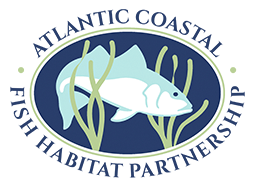The U.S. Fish and Wildlife Service (USFWS) has announced National Fish Habitat Partnership (NFHP) projects approved to receive USFWS-NFHP FY2012 funding. The following three project proposals submitted to the Atlantic Coastal Fish Habitat Partnership (ACFHP) were approved to receive funding:
James River Atlantic Sturgeon Habitat Restoration
A lack of clean, hard substrate has been noted as a limiting factor for the restoration of many anadromous species in the James River. The loss of this ideal spawning habitat is due to dredging and excess sediment entering the river from erosion. This project will promote the population of Atlantic sturgeon (Acipenser oxyrinchus oxyrinchus) and other anadromous fishes of the Chesapeake Bay through the restoration of spawning and nursery habitat. For more information on this project please click here or contact Charles Frederickson, James River Association.
Project text provided by the James River Association.
Restoring the Mangroves of the Indian River Lagoon
The Indian River Lagoon is a 156-mile bar-built coastal estuary that covers an area of approximately 3,575 square kilometers. It supports coastal mangrove wetlands, salt marshes, intertidal and subtidal flats, and riparian wetlands and floodplains, which provide important habitat to numerous fish species. Unfortunately, the rate of shoreline and wetland destruction has increased, due to decades of urbanization and the spread of invasive plant species. This project will restore over 10 acres of coastal habitat wetlands to the Lagoon. For more information on this project please click here or contact the Marine Resources Council of East Florida.
Project text provided by the Marine Resources Council of East Florida.
Eelgrass Restoration with Conservation Moorings in Buzzards Bay
Eelgrass meadows support complex trophic food webs and provide habitat for the forage, shelter and juvenile development of fisheries species. However, this habitat is declining in part due to damage from boating infrastructure. Traditional mooring chains drag on the seafloor, causing direct scour of eelgrass plants and degradation to the quality and function of eelgrass beds through increased turbidity. The project will restore eelgrass (Zostera marina), by replacing traditional moorings with elastic conservation moorings that minimize impacts to the seafloor by preventing chain drag. For more information on this project please click here or contact Tay Evans, Massachusetts Division of Marine Fisheries.
Please note, the mooring of boats and the establishment of mooring fields in seagrass beds is generally recognized as a significant source of damage to these important ecological communities across their range. As such, the Atlantic Coastal Fish Habitat Partnership is only providing support to specific remediation actions at this and other designated project sites, which address historic damage caused by the scouring effects of traditional chain and block-anchor mooring systems.
Project text provided in part by Massachusetts Division of Marine Fisheries.
